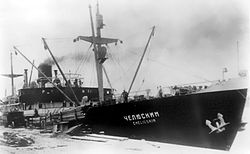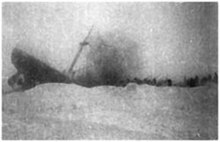Cheliuskin (ship)
|
The Cheliuskin in the port of Leningrad (1933)
|
||||||||||||||||||||||||
|
||||||||||||||||||||||||
|
||||||||||||||||||||||||
|
||||||||||||||||||||||||
The Cheliuskin ( Russian Челюскин , German transcription: Tscheljuskin) was a Soviet ship that undertook an expedition to the Arctic Ocean from 1933 to 1934 to explore the Northern Sea Route. The ship got into the pack ice and sank after an uncontrolled drift . The rescue of the shipwrecked in the Soviet Union led to the foundation of the “ Hero of the Soviet Union ” award .
The ice-class ship was launched in Denmark in 1933 under the name Lena . It was built by Burmeister & Wain in Copenhagen and named after the Russian polar explorer Semyon Ivanovich Tscheljuskin after delivery to the Soviet Union in June 1933 .
The expedition to the Arctic Ocean
Under captain Vladimir Voronin (1890–1952) and Otto Schmidt , the scientific leader of the expedition, the Cheliuskin was supposed to reach the Far East during the short navigation period in the summer months without wintering through the Arctic Ocean. Only the icebreaker Alexander Sibiryakov had succeeded in doing this in 1932 . The trip was supposed to prove that it was possible to transport large amounts of freight across the Northeast Passage without an icebreaker. On July 16, 1933, the cargo steamer lifted anchor in Leningrad . Problems arose in the first leg of the trip. The Cheliuskin was only able to leave Murmansk on August 10, 1933, with a delay of 20 days . The destination of the trip was Vladivostok . Ten women and one child were among the 112 passengers. One of the women was pregnant; while the ship was in the Kara Sea , she gave birth to a girl who was baptized Karina after the Cheliuskin was then resident .
The ship, whose crew included the radio operator Ernst Theodorowitsch Krenkel , of German origin , reached the Chukchi Sea via the Laptev Sea and the East Siberian Sea . In the meantime eight people had left the ship and been brought ashore. On November 4th the Cheliuskin reached the Bering Strait . The open sea was less than a nautical mile away. However, the ship was locked in by the pack ice and could no longer free itself on its own. The captain of the icebreaker Litke , who was in the immediate vicinity of the Cheliuskin , twice offered to help free the ship, but captain Voronin and Schmidt refused: They wanted to end the voyage without help. However, the ship drifted further north with the ice and sank after months of drifting over 1,000 nautical miles on February 13, 1934 in the southern Chukchi Sea, 120 km northeast of the island of Kolyuchin .
The expedition member Boris Mogilewitsch was killed in the sinking of barrels. The remaining 104 sailors and passengers were able to save themselves on an ice floe. The later so-called "Camp Schmidt" was set up there by the castaways. In addition to several accommodations, an airfield was built on the ice floe. By radio communications on shortwave with radio amateurs Krenkel was to inform the outside world about the sinking of the ship and the survivors. Help for those trapped in the ice initially seemed impossible due to the weather conditions. Joseph Stalin refused the aid offered by the United States . After a month the pilot Anatoly Wassiljewitsch Lyapidewski tracked down the castaways. On March 5, 1934, he first brought the ten women and two children with a Tupolev TB-1 to the small town of Uelen on the Chukchi Peninsula . On a second attempt, however, the machine crashed. The government has now sent three groups of aircraft to the Chukchi Peninsula.
Georgi Uschakow , the explorer Severnaya Zemlyas , traveled with the pilots Sigismund Lewanewski and Mawriki Slepnjow (1896-1965) over Europe to Alaska and bought two aircraft. He came to Wankarem with Lewanewski from Nome on March 29 and coordinated the rescue work. However, one of the aircraft broke down and could no longer be used. For this, on April 2, Mikhail Babuschkin appeared on board with the Cheliuskin's poorly repaired aircraft and his mechanic Walawin. On April 7, Slepnyov arrived, who reached Vankarem at the same time as the military pilots Nikolai Kamanin and Vasily Molokov , whose route led from the Kamchatka Peninsula via Anadyr , after a freighter had brought their planes from Vladivostok . On the same day they began to get the castaways off the ice, whereby the maintenance of the runway caused great problems with the constant ice movements. The last to arrive in Vankarem were the pilots Mikhail Wodopyanow and Ivan Doronin , as they - coming from Khabarovsk - had the longest and most difficult route behind them. They took part in the rescue flights from April 12th. On April 13th, the last group with Captain Voronin was taken from the camp. The rescued reached Moscow via Petropavlovsk-Kamchatsky , where they were given a triumphant welcome.
Post-history
On the occasion of the rescue of the shipwrecked, the All-Russian Central Executive Committee decided on April 16, 1934, that the title “Hero of the Soviet Union” was donated and awarded to seven aviators involved.
These seven pilots were Anatoly Lyapidewski, Sigismund Lewanewski, Wassili Molokow, Mawriki Slepnjow, Michail Wodopjanow, Nikolai Kamanin and Ivan Doronin. Clyde Armistead and William Latimer Lavery, two American aircraft mechanics who were also involved in this air rescue mission for the ship, were awarded the Order of Lenin on September 10, 1934 .
In the 1970s and again in 2004, several expeditions searched unsuccessfully for the wreck of the Cheliuskin . In September 2006, Russian divers were able to locate the ship, which is about 50 meters below the Siberian coast, and recover some artifacts. The recovered finds are to be checked for authenticity in Denmark, the country of origin of the ship.
Movie
In 1970, the film Tscheljuskin was made in the GDR with Eberhard Mellies , Dieter Mann and Jürgen Frohriep .
literature
- Sergey Tret'jakov, Leonid Muchanov, S. Dikowski: Tscheljuskin: a country saves its sons . with photos and maps. Ed .: Sergey Tret'jakov. Publishing Cooperative for Foreign Workers in the USSR, Moscow 1934, DNB 361238045 (Russian, table of contents ).
- Ernst Krenkel: My callsign is RAEM [ Мои позывные - RAEM ; in Dt. transfer by Leon Nebenzahl - shortened for the German edition]. Verlag Neues Leben, Berlin 1977, 474 pp.
- An action the world has never seen before . In: The world
Web links
Individual evidence
- ↑ a b c d e f g h i Entry in Lloyd's Register 1933/34 (PDF; English)
- ↑ Construction list of the Burmeister & Wain shipyard . ( Memento of April 28, 2016 in the Internet Archive ; PDF) (Danish)
- ↑ G. Ushakow: My pobjedili w boju pod Vankarenom . (Russian)
- ↑ Incident and reception are mentioned in Ilja Ehrenburg's memoir People - Years - Life . Munich 1962/1965, Volume 2: 1923–1941, p. 347. Ehrenburg notes that one of those who had been rescued told him that they had carried a volume of Pushkin with them on the ice floe and that they read each other poems to cheer them up. "Could a writer hear this report without deep excitement?"
- ↑ The Junior Aircraft Year Book , 1935, p. 8 (English)


